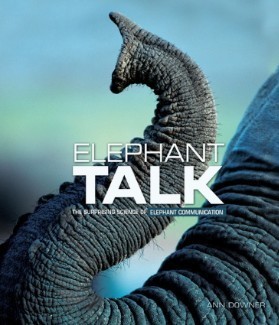ELEPHANT TALK
Elephant Talk
The Surprising Science of Elephant Communication
By Ann Downer
Twenty-First Century Books, Lerner, 2011
ISBN #978-0-7613-5766-7
Nonfiction
Ages 11-18
"It is early morning in Amboseli National Park in Kenya, Africa. A baby elephant hurries to keep up with his mother and sisters and aunts as the herd moves out, following the eldest female to a stand of acacia trees. They will spend the morning browsing o acacia bark and grass."
This fascinating insight into fellow mammals and the capabilities they display in communication and to their families delights and amazes. From the first page, author Ann Downer takes the reader on an exploration of the ins and outs of the latest research information about elephants to the final chapter, where she revisits a zoo.
From early studies to research pioneers to the current body of knowledge growing about the various kinds of elephants, a fantastic language comes to life. Elephants have a set of trumpets, chirps, rumbles, and other calls identified by elephant scientists and set down in a universal language of elephant talk. The bonds of the herd, babies and care, and maturing males, females, and grandmothers are explored in detail. The newest information concerning elephants' ability to sense rumbles and vibrations through their feet promises more knowledge. It abounds with science and details and is filled with vibrant, interesting photographs that add to the wonder of this mighty animal.
The author explores the changing human relationship between elephant and humans. She looks at changes in elephant training and how elephants bring out the "wow" factor. She discusses the problems of zoos versus loss of habitat and poaching as the possibly looms of the elephants' eventual extinction in our lifetime.
Full back matter includes a bibliography, further reading, glossary, index, source notes, timeline, TOC, and websites. This is a book sure to please budding scientists, reluctant readers, nonfiction lover, and anyone interested in animals–and it's a fun read. This book belongs in every nonfiction collection.
Now this is a fun one. Listen to elephants here. I had make myself stop listening. Keep clicking through and start the sound, too.
I loved this book and it fits right in with NOVA's "Secret Life of Scientists" web program and scientist Dave Sulzer. Take a look at what he'd done with elephants—and it involves music! I'll be guest blogging about his musical elephants soon.
Scan the scientists to find him if he's not right up front.
Another excellent elephant book for younger kids is Beco's Big Year by Linda Stanek and the Columbus Zoo. Stanek does a wonderful job in showing the baby elephant's development without being cute or anthropomorphic. See my review of Beco.
See a terrific Beco review and more at Growing with Science.
Activity 1
Compare the differences between Asian and African elephants and write about them to explain those differences in relation to their habitats and characteristics.
Activity 2
Choose one of the elephant researchers discussed in the book and research their studies. Write about what they've learned and what's yet to learn about elephants.
Activity 3
Give an example of how the scientific method was used by one or more of the researchers from the book and explain how it contributed to the body of knowledge.
See more about elephants at the American Zoological Association site.
How you can help.
National Science Standard: biological evolution and behavior of organisms
Book provided by publisher.








Shirley Smith Duke's Blog




